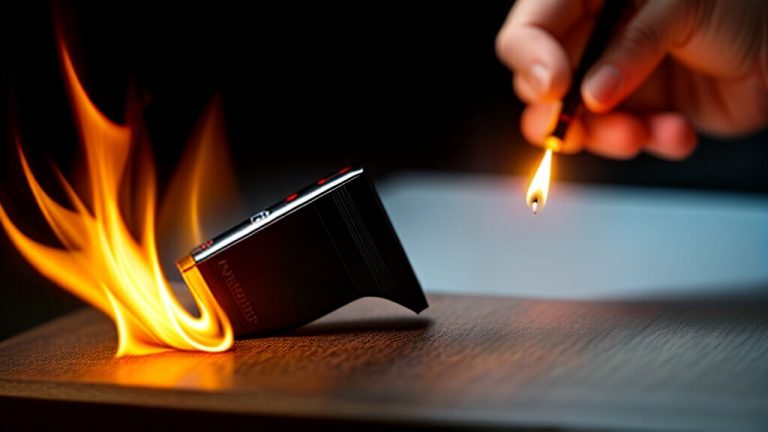If you’re a smoker or an outdoor enthusiast, you know the frustration that comes with a lighter that won’t stay lit. A reliable flame is essential for lighting cigarettes, starting a campfire, or igniting a stove. Fortunately, there are simple steps you can take to ensure your Bic lighter stays lit every time. In this article, we’ll walk you through the mechanics of Bic lighters, provide tips for maintenance and cleaning, and offer techniques for windproofing the flame. By following these easy steps and tips, you’ll enjoy a consistently lit Bic lighter whenever needed; also, know to buy Zippo lighter fluid.
Key Takeaways:
- A Bic lighter that won’t stay lit can be frustrating, but there are simple steps you can take to ensure a reliable flame.
- Familiarize yourself with the basic mechanics of a Bic lighter, including the fuel supply, ignition system, and flame adjustment.
- Check and refill the fuel regularly to prevent issues related to low fuel levels, air bubbles, or clogged fuel ports.
- Adjust the flame height to optimize performance and ensure a steady flame.
- Practice proper ignition techniques to ensure a smooth and steady motion when striking the ignition wheel.
- Protect the flame from wind or drafts by cupping the lighter or using a windproof case.
- Regularly maintain and clean your Bic lighter to prolong its lifespan and ensure functionality.
- Store the lighter properly in a dry and cool environment, away from direct sunlight and extreme temperatures.
- Always handle and use the lighter safely, keeping it out of reach of children and following proper extinguishing procedures.
Understanding Bic Lighter Mechanics
A Bic lighter has a simple design and is popular for lighting cigarettes, candles, and campfires. It consists of a fuel supply, ignition system, and flame adjustment. The fuel supply is a pressurized butane gas container in the lighter’s body. The ignition system has a wheel and flint that create a spark when struck together. The flame adjustment is a small dial located at the bottom of the lighter that controls the height of the flame.
Common reasons why a Bic lighter may not stay lit include an insufficient fuel level, a faulty ignition system, or improper flame adjustment. If the fuel level is low, the lighter may not light or may only produce a weak flame. Similarly, a faulty ignition system may prevent the lighter from igniting. At the same time, an improper flame adjustment can result in a flame that’s too high or too low, causing it to extinguish quickly.
Understanding the basic mechanics of a Bic lighter can help you diagnose and fix common problems to ensure a reliable flame every time you use it.
Checking and Refilling the Fuel
One of the most common reasons why a Bic lighter may not stay lit is due to a low fuel level. Checking the fuel level is the first step in troubleshooting the problem.
Start by holding the lighter upright and depressing the fuel adjustment wheel to check the fuel level. Look inside the fuel chamber window to determine the fuel level. The fuel should be visible; if it is not, the lighter must be refilled.
Before refilling the lighter, ensure it is completely cool and free of any external heat sources. Remove the child-resistant mechanism and insert the fuel canister nozzle into the fuel valve at the bottom of the lighter. Depress the canister nozzle for several seconds to refill the lighter. If air bubbles appear in the fuel chamber window, repeat the refilling process and depress the fuel valve more slowly.
It is recommended to use butane fuel for optimal Bic lighter performance. Other fuel types, such as propane or gasoline, can cause damage to the lighter’s internal components and affect its ability to stay lit.
If the lighter still won’t hold a flame after refilling the fuel, there may be a clog in the fuel ports. Use a small tool, such as a paper clip or toothpick, to gently clear any debris or blockage from the fuel ports.
Adjusting the Flame
Adjusting the flame on a Bic lighter is crucial to maintaining a reliable flame. The correct flame height is essential for the lighter to stay lit and perform optimally. A flame that is too low may result in the lighter not staying lit, while a flame that is too high may waste fuel and create a larger flame that is difficult to control.
To adjust the flame on a Bic lighter, locate the flame adjustment mechanism, which is usually a small screw located at the base of the flame. Use a small screwdriver or a similar tool to turn the screw in a clockwise or counterclockwise direction to adjust the flame height. It’s important to make small adjustments and test the flame between each adjustment to avoid damaging the lighter.
Once you have adjusted the flame to the desired height, monitor it periodically to ensure it remains at the correct level. A fluctuating flame may indicate an issue with the lighter’s fuel supply or ignition system that should be addressed promptly.
Proper Ignition Technique
One of the most important factors in making sure your Bic lighter stays lit is using the proper ignition technique. Start by positioning the lighter in your hand with your thumb on the ignition wheel. Ensure your grip is firm but not too tight to allow smooth movement.
When striking the ignition wheel, use a smooth and steady motion. Don’t flick your wrist or strike too hard, as this can cause the flame to go out. Instead, focus on a controlled strike with consistent pressure.
Hold the lighter upright for optimal results, and position your thumb on the side opposite the ignition wheel. This will give you maximum control over the flame and help you avoid any accidental burns.
Windproofing the Flame
Protecting the flame of your Bic lighter from wind or drafts is crucial for maintaining a consistent and reliable flame. Wind can easily blow out a lighter flame, making lighting candles, cigarettes, or other objects difficult.
One effective technique for windproofing the flame is to cup the lighter with your hand while using it. This blocks the wind from hitting the flame and keeps it burning steadily. Another option is a windproof lighter case, which provides a barrier against the wind and protects the flame.
Windproof Lighters
If you often find yourself in windy conditions or need a lighter for outdoor activities, you may want to invest in a windproof lighter. These lighters are designed to withstand strong winds and keep the flame lit, making them ideal for camping, hiking, or other outdoor activities.
Windproof lighters feature a protective cover that shields the flame from the wind, ensuring it stays lit even in the strongest gusts. Some models also have additional features like a waterproof design, a built-in flashlight, or a safety lock to prevent accidental ignition.
Keeping the Lighter Clean
Regular maintenance and cleaning are essential to ensure the optimal performance and longevity of your Bic lighter. Here are some step-by-step instructions to keep your lighter clean and functioning properly:
| Cleaning Component | Procedure |
|---|---|
| Ignition Wheel | Use a dry cloth or paper towel to gently wipe the ignition wheel, removing any dirt or debris that may have accumulated. |
| Fuel Ports | Use a thin object, such as a straightened paper clip, to remove debris from the fuel ports. Use a cotton swab dipped in rubbing alcohol to clean the ports if they are clogged. |
| Exterior | Use a damp cloth to clean the exterior of your lighter, removing any dirt or grime. Be careful not to soak the lighter in water or let any liquid into the fuel compartment. |
Proper cleaning and maintenance can also help identify any issues before they become major problems. If your lighter is still malfunctioning after cleaning, consider contacting Bic customer support for assistance.
Storing the Lighter Properly
Proper storage is crucial for maintaining the functionality of your Bic lighter. Here are some best practices to follow:
- Store your lighter in a dry and cool environment, away from direct sunlight and extreme temperatures.
- Keep lighters out of reach of children to avoid accidents or misuse.
- When storing spare lighters and fuel cans, keep them away from any potential sources of heat or flames.
By following these simple storage guidelines, you can help prolong the lifespan of your lighter and keep it functioning optimally.
Safety Precautions
It is important to handle and use a Bic lighter cautiously to avoid the risk of burns or accidents. Keep lighters out of reach of children and avoid exposing them to extreme heat or open flames.
When lighting a Bic lighter, ensure that your thumb is positioned correctly and avoid using excessive force. Extinguish the flame safely by blowing it out gently or pressing it down on the ignition wheel until it is fully extinguished.
Do not tamper with the inner workings of the lighter or attempt to modify it in any way. If you encounter any issues with your Bic lighter, refer to the manufacturer’s instructions or seek professional assistance.
Conclusion
Following the tips and techniques outlined in this article, you can ensure that your Bic lighter stays consistently lit every time you use it. Remember to check and refill the fuel, adjust the flame height, use the proper ignition technique, protect against wind, keep it clean, store it correctly, and prioritize safety at all times.
With just a little bit of maintenance and attention, your Bic lighter can provide a reliable flame for various uses, from lighting candles to starting a campfire. So why settle for a lighter that keeps going out when you can have a consistently lit flame with these easy steps and tips?

I’m Alfred Davis, and I’m all about lighters. Hailing from the great state of Texas, USA, I’ve cultivated a deep passion for these fascinating gadgets. With years of hands-on experience and a burning curiosity (pun intended), I’ve become an expert in all things related to lighters.
My journey with lighters began as a hobby and quickly became a full-blown obsession. I’ve explored the diverse world of lighters inside and out, from classic Zippo designs to modern plasma arc models. I’ve tested, tinkered with, and even collected rare pieces while learning the intricate mechanics and unique histories behind each one.
Through my writing, I aim to share my knowledge, insights, and reviews to help you make informed decisions about choosing the perfect lighter. Whether you’re a seasoned collector or just looking for a reliable fire source, I’ve got you covered. Join me in unraveling the fascinating realm of lighters right here at LightersInfo, where ignition meets expertise.
Alfred Davis

